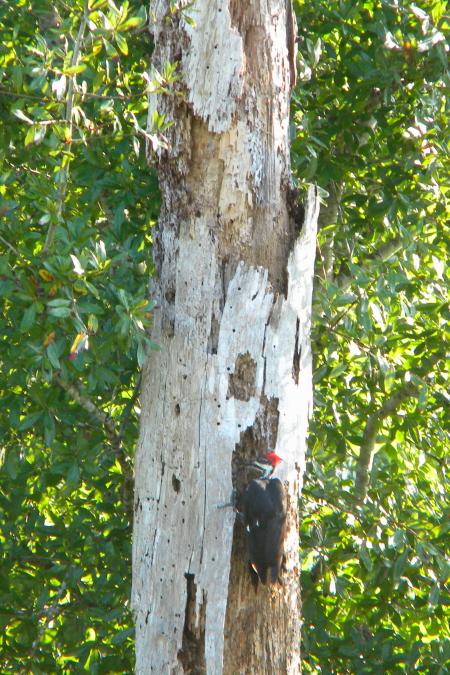This tale was originally published by Loret T. Setters on April 16, 2014 at the defunct national blog nativeplantwildlifegarden[dot]com. Click the date to view reader comments and find working links to other stories.
 I live in a Pine Flatwoods Ecosystem and have been allowing several Longleaf Pine (Pinus palustris) and Slash Pine (P. elliottii) trees to naturally restore on various spots of my property. The property had been clear-cut by prior owners, sans a few of these pines.
I live in a Pine Flatwoods Ecosystem and have been allowing several Longleaf Pine (Pinus palustris) and Slash Pine (P. elliottii) trees to naturally restore on various spots of my property. The property had been clear-cut by prior owners, sans a few of these pines.
 Longleaf Pine is an evergreen, hurricane resistant tree that can reach a massive height of up to 120 ft. It is native to the southern United States from Virginia down to Florida and across to Texas. It is monoecious (bears both seed and pollen cones in separate structures on the same plant).
Longleaf Pine is an evergreen, hurricane resistant tree that can reach a massive height of up to 120 ft. It is native to the southern United States from Virginia down to Florida and across to Texas. It is monoecious (bears both seed and pollen cones in separate structures on the same plant).
There are various stages of growth in a Longleaf Pine Tree. In addition to several mature specimens I have about 15 or more that are in various growing lifecycles.

Seed stage: seeds are winged and are contained within female pinecones. The male pollen cones are called catkins. The seeds are sometimes referred to as “pine nuts” and are used in cooking.

Grass stage: can last one to seven years, depending upon competition with other plants. This is when the root system is established. At this stage, more grows beneath the soil than above and the pine is virtually immune to fire, which is a common occurrence in pine ecosystems. Note that the tree is capable of sprouting from the root collar if its top is damaged.

Bottlebrush stage: a white tip, known as a candle, begins to emerge. The bottlebrush stage is when it works on gaining height, bark begins to form, but no branches are apparent. This stage can last a couple of years.

Sapling stage: As the young pine reaches 6-10 feet, it starts to form the lateral branching of this stage which lasts several years.

Mature stage: where they grow from 60-110 feet. It begins producing cones when it reaches about 30 years of age or 10 inches diameter. Pinecones are fun to use in craft projects such as natural bird feeders (smear with peanut butter and roll in seeds) or sprinkle with glitter to make a lovely holiday table display.

Old growth: (nearly nonexistent with clear cutting in the early 1900s)

Death: The height of these lanky trees just begs lightening bolts to hit so they meet their demise. Other causes of death can be disturbance of root systems. At this point they are referred to as “snags“.

After Death: the last stage and one that is surprisingly vital to providing for wildlife in a biodiverse ecosystem.


The needles make excellent mulch known as pine straw. The Long Leaf Pine tree has needles in bundles of 3 (or occasionally 4) known as fascicles. The needles are 8 to 18 inches long.

The Slash Pine species are similar but grow a little more quickly. To distinguish Slash Pines look for needles in fascicles of 2 or occasionally 3 that are 5 to 12 inches long.

Sixty-eight species of birds utilize Longleaf Pine trees. It addition, it provides habitat and food for numerous mammals and reptiles.

Insect decomposers recycle the rotting wood. These decomposing insects are vital protein food resources for developing birds and mammals.
Lollipop stage: A cross between grass, bottlebrush and sapling stages, possibly a specimen regenerated from the collar after damage. Ok, I made this stage up ![]()

So, as you can see, all stages play an important role. It is an amazing journey to watch the age progression of the Longleaf pines. Patience required but amply rewarded with so much beauty, diversity and activity.


3 thoughts on “Life Cycle of the Long-Leaf Pine Tree”